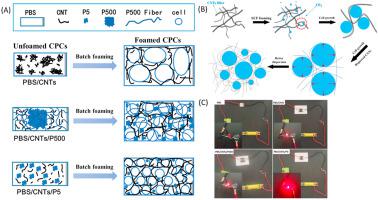当前位置:
X-MOL 学术
›
Compos. Sci. Technol.
›
论文详情
Our official English website, www.x-mol.net, welcomes your
feedback! (Note: you will need to create a separate account there.)
Facile preparation of Poly(butylene succinate)/Carbon Nanotubes/Polytetrafluoroethylene Ternary Nanocomposite Foams with Superior Electrical Conductivity by Synergistic Effect of “Ball Milling” and Supercritical Fluid-Assisted Processing
Composites Science and Technology ( IF 8.3 ) Pub Date : 2021-01-01 , DOI: 10.1016/j.compscitech.2020.108519 An Huang , Jialin Lin , Shudong Chen , Hui Fang , Hankun Wang , Xiangfang Peng
Composites Science and Technology ( IF 8.3 ) Pub Date : 2021-01-01 , DOI: 10.1016/j.compscitech.2020.108519 An Huang , Jialin Lin , Shudong Chen , Hui Fang , Hankun Wang , Xiangfang Peng

|
Abstract Conductive polymer composites (CPCs) with different types of polytetrafluoroethylene (PTFE) were prepared via melt mixing, and the cellular structure was introduced into poly(butylene succinate) (PBS) by the supercritical CO2 foaming technique. The carbon nanotubes (CNTs) had the best dispersion in the PBS/CNTs/PTFE-P5 composite (PTFE with a diameter of approximately 5–10 μm). The CNTs enhanced the crystallizability of PBS, and the addition of PTFE was more significant, especially PTFE-P5. The storage modulus increased, and a transition from liquid-like to solid-like behavior occurred at low frequencies. Adding PTFE dramatically improved the pore structure, leading to a two-orders-of-magnitude increase in pore density, especially for PTFE-P5. The conductivity (δ) of solid PBS/CNTs/PTFE-P5 was four times higher than that of PBS/CNTs. The δ values of all the foams were much higher than those of their solid counterparts, demonstrating that the introduction of a large number of pores optimized the dispersion of CNTs and further improved the electrical conductivity because of the formation of a more complete conductive network structure (CNS). In particular, the δ value of foamed PBS/CNTs/PTFE-P5 under 3 wt.% CNT loading reached 54.05 S/m. The thermal and mechanical properties, as well as the thermal conductivity, were also investigated. This work provides a simple method to prepare flexible biodegradable CPCs with a highly dispersed CNT CNS under high melt viscosity conditions.
中文翻译:

通过“球磨”和超临界流体辅助加工的协同效应,轻松制备具有优异导电性的聚(丁二酸丁二醇酯)/碳纳米管/聚四氟乙烯三元纳米复合泡沫
摘要 通过熔融混合制备了不同类型聚四氟乙烯(PTFE)的导电聚合物复合材料(CPCs),并通过超临界二氧化碳发泡技术将多孔结构引入聚丁二酸丁二醇酯(PBS)中。碳纳米管 (CNTs) 在 PBS/CNTs/PTFE-P5 复合材料(直径约为 5-10 μm 的 PTFE)中具有最佳分散性。CNTs增强了PBS的结晶能力,PTFE的加入更为显着,尤其是PTFE-P5。储能模量增加,并且在低频下发生从类液体到类固体行为的转变。添加 PTFE 显着改善了孔结构,导致孔密度增加了两个数量级,尤其是 PTFE-P5。固体 PBS/CNTs/PTFE-P5 的电导率 (δ) 是 PBS/CNTs 的四倍。所有泡沫的 δ 值均远高于其固体对应物的 δ 值,表明大量孔的引入优化了 CNT 的分散,并由于形成了更完整的导电网络结构而进一步提高了导电性。中枢神经系统)。特别是,在 3 wt.% CNT 负载下发泡 PBS/CNTs/PTFE-P5 的 δ 值达到 54.05 S/m。还研究了热和机械性能以及热导率。这项工作提供了一种在高熔体粘度条件下制备具有高度分散的 CNT CNS 的柔性可生物降解 CPC 的简单方法。证明大量孔的引入优化了碳纳米管的分散,并由于形成了更完整的导电网络结构(CNS)而进一步提高了导电性。特别是,在 3 wt.% CNT 负载下发泡 PBS/CNTs/PTFE-P5 的 δ 值达到 54.05 S/m。还研究了热和机械性能以及热导率。这项工作提供了一种在高熔体粘度条件下制备具有高度分散的 CNT CNS 的柔性可生物降解 CPC 的简单方法。证明大量孔的引入优化了碳纳米管的分散,并由于形成了更完整的导电网络结构(CNS)而进一步提高了导电性。特别是,在 3 wt.% CNT 负载下发泡 PBS/CNTs/PTFE-P5 的 δ 值达到 54.05 S/m。还研究了热和机械性能以及热导率。这项工作提供了一种在高熔体粘度条件下制备具有高度分散的 CNT CNS 的柔性可生物降解 CPC 的简单方法。也被调查了。这项工作提供了一种在高熔体粘度条件下制备具有高度分散的 CNT CNS 的柔性可生物降解 CPC 的简单方法。也被调查了。这项工作提供了一种在高熔体粘度条件下制备具有高度分散的 CNT CNS 的柔性可生物降解 CPC 的简单方法。
更新日期:2021-01-01
中文翻译:

通过“球磨”和超临界流体辅助加工的协同效应,轻松制备具有优异导电性的聚(丁二酸丁二醇酯)/碳纳米管/聚四氟乙烯三元纳米复合泡沫
摘要 通过熔融混合制备了不同类型聚四氟乙烯(PTFE)的导电聚合物复合材料(CPCs),并通过超临界二氧化碳发泡技术将多孔结构引入聚丁二酸丁二醇酯(PBS)中。碳纳米管 (CNTs) 在 PBS/CNTs/PTFE-P5 复合材料(直径约为 5-10 μm 的 PTFE)中具有最佳分散性。CNTs增强了PBS的结晶能力,PTFE的加入更为显着,尤其是PTFE-P5。储能模量增加,并且在低频下发生从类液体到类固体行为的转变。添加 PTFE 显着改善了孔结构,导致孔密度增加了两个数量级,尤其是 PTFE-P5。固体 PBS/CNTs/PTFE-P5 的电导率 (δ) 是 PBS/CNTs 的四倍。所有泡沫的 δ 值均远高于其固体对应物的 δ 值,表明大量孔的引入优化了 CNT 的分散,并由于形成了更完整的导电网络结构而进一步提高了导电性。中枢神经系统)。特别是,在 3 wt.% CNT 负载下发泡 PBS/CNTs/PTFE-P5 的 δ 值达到 54.05 S/m。还研究了热和机械性能以及热导率。这项工作提供了一种在高熔体粘度条件下制备具有高度分散的 CNT CNS 的柔性可生物降解 CPC 的简单方法。证明大量孔的引入优化了碳纳米管的分散,并由于形成了更完整的导电网络结构(CNS)而进一步提高了导电性。特别是,在 3 wt.% CNT 负载下发泡 PBS/CNTs/PTFE-P5 的 δ 值达到 54.05 S/m。还研究了热和机械性能以及热导率。这项工作提供了一种在高熔体粘度条件下制备具有高度分散的 CNT CNS 的柔性可生物降解 CPC 的简单方法。证明大量孔的引入优化了碳纳米管的分散,并由于形成了更完整的导电网络结构(CNS)而进一步提高了导电性。特别是,在 3 wt.% CNT 负载下发泡 PBS/CNTs/PTFE-P5 的 δ 值达到 54.05 S/m。还研究了热和机械性能以及热导率。这项工作提供了一种在高熔体粘度条件下制备具有高度分散的 CNT CNS 的柔性可生物降解 CPC 的简单方法。也被调查了。这项工作提供了一种在高熔体粘度条件下制备具有高度分散的 CNT CNS 的柔性可生物降解 CPC 的简单方法。也被调查了。这项工作提供了一种在高熔体粘度条件下制备具有高度分散的 CNT CNS 的柔性可生物降解 CPC 的简单方法。











































 京公网安备 11010802027423号
京公网安备 11010802027423号